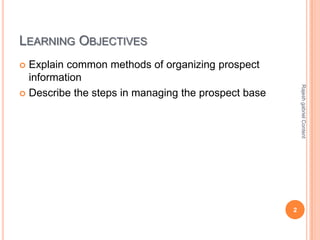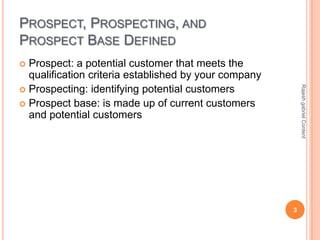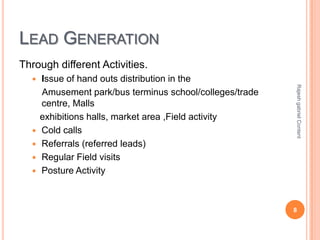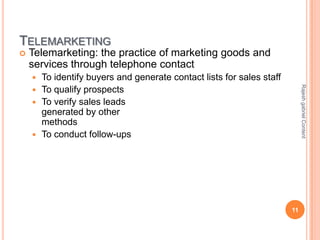Prospecting Skills
- 2. Discuss the importance of developing a prospect base Identify and assess important sources of prospects Describe criteria for qualifying prospects l Rajesh gabriel Content LEARNING OBJECTIVES 1
- 3. LEARNING OBJECTIVES Explain common methods of organizing prospect information Describe the steps in managing the prospect base Rajesh gabriel Content 2
- 4. PROSPECT, PROSPECTING, AND PROSPECT BASE DEFINED Prospect: a potential customer that meets the qualification criteria established by your company Prospecting: identifying potential customers Prospect base: is made up of current customers and potential customers Rajesh gabriel Content 3
- 5. IMPORTANCE OF PROSPECTING Every salesperson must cope with customer attrition: Rajesh gabriel Content Customer may have a one-time need Customer may move outside the salesperson’s territory Firm may go out of business or merge Sales may be lost to the competition 4
- 6. PROSPECTING REQUIRES PLANNING Increase number of people visit by increasing cold calls Improve the quality of prospects Shorten sales cycle by determining which prospects are “qualified” Prospecting plans must be monitored continuously for effectiveness Rajesh gabriel Content 5
- 7. SOURCES OF PROSPECTS Website Computerized database Cold calling Networking Educational seminars Prospecting by nonsales employees Rajesh gabriel Content Referrals Centers of influence Directories Trade publications Trade shows and special events Telemarketing and e-mail Direct-response advertising and sales letters 6
- 8. REFERRALS recommended by current satisfied customer or one familiar with product or service Endless chain: ask contact who else could benefit from product Referral organizations: facilitate networking Friends, family members, centers of influence: a person who may have influence on opinion leaders Rajesh gabriel Content Prospect 7
- 9. LEAD GENERATION Through different Activities. Rajesh gabriel Content Issue of hand outs distribution in the Amusement park/bus terminus school/colleges/trade centre, Malls exhibitions halls, market area ,Field activity Cold calls Referrals (referred leads) Regular Field visits Posture Activity 8
- 10. DIRECTORIES Hundreds of business and industrial directories available Many major trade associations publish directories Be sure to use current copy or edition as prospects shift firms; track people and companies Rajesh gabriel Content 9
- 11. TRADE SHOWS/PUBLICATIONS Trade Rajesh gabriel Content shows and conventions: your company may have a booth at key trade shows/expositions Trade publications: each industry has trade publications that sales professionals need to read Join trade associations: many salespersons join trade associations to gain access to potential buyers 10
- 12. TELEMARKETING Telemarketing: the practice of marketing goods and services through telephone contact To identify buyers and generate contact lists for sales staff To qualify prospects To verify sales leads generated by other methods To conduct follow-ups Rajesh gabriel Content 11
- 13. DIRECT RESPONSE AND SALES LETTERS Direct Rajesh gabriel Content response advertising: often features inquiry cards or information requests via mail or telephone Sales letters: send sales letters to decision makers, then follow up 12
- 14. WEBSITE Websites provide a cost-effective way for sales professionals to: Project personal image Provide additional information Generate leads from visitors to site Present product information Establish e-mail lists Rajesh gabriel Content 13
- 15. COLD CALLING Simply calling prospects without referrals New salespeople rely on these as they haven’t built a referral base Must be strategically planned Prelude to in-person appointment A way to introduce yourself and your company to a prospect 14 Rajesh gabriel Content
- 16. NETWORKING Rajesh gabriel Content Making and profiting from personal connections Networking guidelines Meet as many people as you can Tell them what you do Do not do business while networking Offer business card Edit contacts and conduct follow-ups 15
- 17. THREE TYPES OF NETWORKS Rajesh gabriel Content 16
- 18. NON-SALES EMPLOYEES Non-sales personnel can be valued source of leads Prospecting not necessarily exclusive task of sales force Non-sales personnel often need training and incentives Rajesh gabriel Content 17
- 19. COMBINATION APPROACHES Salespersons generally rely on combination of prospecting methods Some methods have higher yield than others Important to use Customer Relation Managing technology to help maximize efficiency Rajesh gabriel Content 18
- 20. QUALIFYING PROSPECTS Does the prospect have the authority to buy my product? Does the prospect have the financial resources to buy my product? Does the prospect have the willingness to buy my product? 19 Rajesh gabriel Content Basic questions: Does the prospect need my product?
- 21. COLLECTING AND ORGANIZING PROSPECT INFORMATION data can be collected and organized into Customer Relationship Management (CRM) Examples of popular applications: Rajesh gabriel Content Sales Excel Word 20
- 22. PROSPECTING AND SALES FORECASTING PLANS Rajesh gabriel Content Important to balance time and organize contacts: Prepare a list of prospects Forecast potential sales volume for each new account, by product Carefully plan the sales route to minimize time and cost 21
- 23. KEY CONCEPT DISCUSSION QUESTIONS Discuss the importance of developing a prospect base Identify and assess important sources of prospects Describe criteria for qualifying prospects Explain common methods of collecting and organizing prospect information Describe the steps in managing the prospect base 9-23 Rajesh gabriel Content






















